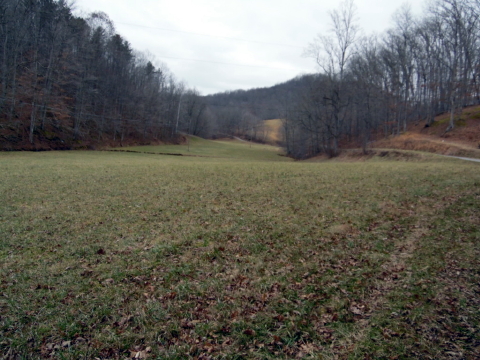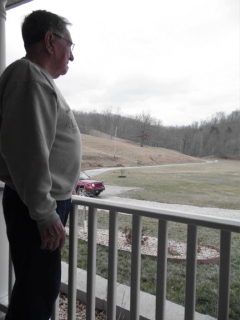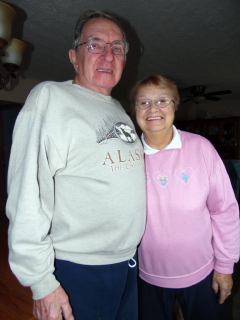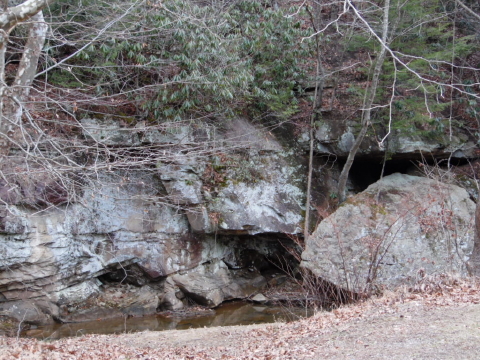
You once could hear gunshots echoing across the hills, "Hurrah for Booger Hole," an ominous yell often repeated, likely a fightin' song, but transformed into a melody, "Goin' up Booger Hole, goin' in a run, Goin' up Booger Hole to have a little fun. Goin' up Booger Hole, goin' in a pace, Rather go to Booger Hole than any other place."
By Bob Weaver
We have spent some days over the years in Booger Hole, a well-known Clay County holler shrouded in mystery, myth and murder.
The holler is located south of the Big Otter I-79 exchange, a short distance off State Route 16 up Rush Fork near a village known as Dink. Today, the community is filled with modern houses and well-kept farms, with nary a hint of its treacherous past.
Marlyn Starcher, who now lives in Booger Hole, said one of the old timers told him he would not spend one night in the house on property Starcher purchased about 1980. "Most of the old-timers really believed in the ghost stories," he said.
The old-timer said one of many ghosts inhabited the place and would surely bring harm to him. Marlyn's wife Dottie said "I have been wanting to see a ghost all these years, but they just won't come out."
The original log house on Starcher's farm was built in 1883 by Ode Moore. "Moore was said to have a son who was chained to the wall. He tried to burn himself loose, the charred marks are still on the cabin wall," said Starcher. He sold the cabin a few years ago and it was moved from the property.


Marlyn, a Clay County auctioneer, looking
down now peaceful Booger Hole, Marlyn and
wife Dottie enjoy the modern-day community
Starcher said nearly all the story-tellers are gone, certainly those who remembered the murderous events and could tell the ghostly stories that sent chills up the spine.
The best account of Booger Hole is recorded in a small book written by Clay County resident Mary Lucinda Curry - "Booger Hole, Mysteries, Ghost Tales And Strange Occurrences."
Curry first published her "Booger Hole" book
in 1990 and it is still available after all these years: Cindy
Curry, 3320 Ossia Road, Duck WV 25063, Send $5 plus $2 postage for
your fascinating copy of strange times in the Clay backwoods
One of the area's best known ghost tales was "The Cryin' Babies," which was said to have happened in the holler behind Starcher's country home, according to Dottie Starcher.
The tiny house was haunted by crying babies that had been murdered. The mother of the children was said to have thrown the babies into the fire just after they were born because she didn't want children. The house burned down, their cries never to be heard again.
"Right here in this holler there's a tale of a great white dog that would run out to attack. They said when it neared its assailant, it would disappear. I heard that story over and over," he said.
Starcher said just over the hill is Battle Run. "A lot of things happened there, and not just ghost stories," he said.
Booger Hole has a long and lingering history of sordid tales, killings, missing persons and bad luck, some of which are true.
Bushwhackers, home guards and loosely organized renegades from Civil War days may well have been the underlying force behind the violence in "The Hole." Early settlers who lodged themselves in the remote hollow, were people who were likely running away from something, and some had an outlaw past.
"Captain" Perry Conley's renegades, with deep roots in Calhoun County, played havoc with some of Booger Hole's early settlers. Conley, known as the "Quantrel of West Virginia," was the organizer of the infamous Moccasin Rangers. Riding with Conley was his girlfriend, the notorious lady guerrilla, Nancy Hart.
James Rogers, a well respected farmer and religious man, whose father was an original settler, helped organize a local home guard unit in Booger Hole. Their allegiance was to neither north nor south, but whose mission was to protect the holler's families from either side.
Rogers and a neighbor Soloman Carpenter were patrolling the holler one night when they encountered and followed a band of guerrillas, likely members of the Moccasin Rangers.

Realizing some of the members were Confederate sympathizers from Booger Hole coming home for a rest, Rogers and Carpenter gave up their patrol and returned to their houses.
Captain Perry Conley and some Moccasin members pulled Rogers and Carpenter from their beds, took them up a nearby holler and tied them to a tree.
They riddled them with bullets, their family members finding their bodies the next day. The local Confederate sympathizers, angered by Captain Conley's slayings, went in pursuit of the Captain and his bushwhackers.
Conley continued to participate his the war within the war in the region, but many of the home guard units turned against him.
In 1861 the Braxton home guards, mostly Union sympathizers, found Perry Conley and Nancy Hart on Stinson in Calhoun, firing upon them.
Hart was taken prisoner but Conley escaped and later engaged the Thirteenth Ohio Infantry in Webster County, where he was shot and killed. Hart escaped and went south to Nicholas County.
With the Moccasin Rangers gone and the war over, some of the bushwhackers returned to Booger Hole and confiscated property.
Outsiders were not welcome, which partly accounts for the surge of frightening myths and ghost tales, and more real-life atrocities for the next fifty years.
Lacy O'Brien Boggs, described as a peculiar old woman, was shot through the window of her house as she sat before a fireplace, rocking in her chair and peeling apples. Some claimed she was a witch, but others said she knew too much about murders.
Boggs was the granddaughter of famous West Virginia explorer Adam O'Brien, who moved to the West Fork section of Calhoun shortly after 1800. O'Brien, who lived to be over 100, was married at least four times and had many children.
Two Cottrell's, father and son, were charged with the old woman's murder. The men told a Clay County squire the woman witched them and had the power to change forms. With insufficient evidence, the squire released them.
Old-timers believe the old woman was killed because she knew too much about the death of a pack peddler, having made claims she knew where his bones rested.
Another mysterious case was the disappearance of Andrew Hargess. Booger Hole resident James Moore would go into spells of shouting and screaming, gazing at the ground as if something was about to rise from the soil.
Some thought Moore may have killed Hargess, but many others disappeared without a trace in the dark holler.
Preston Tanner had his head bashed in by a claw hammer, after a night of card playing with twenty-one-year old Howard Sampson.
Howard Sampson and his father, Andrew, were accused of the murder, after the Tanner house was burned to the ground. Howard was believed to be in love with Preston Tanner's beautiful wife. He boasted of wanting her, even if he had to kill her husband.
Sampson was well-known for his unlawful escapades, and had been arrested for "fighting, shooting and cutting" around Booger Hole.
A lynch mob from Booger Hole rode to Clay County Courthouse to put the Sampson's to death before they were brought to trial. Clay's main street filled with a riotous mob, which was settled by the words of a local attorney, pleading with them to let justice take its course.
A jury found the younger Sampson guilty, sentencing him to life in prison and preventing his execution. The older Sampson returned to his home up Booger Hole.
The Booger Hole mob, riled over the court's decision, took to their mounts and demanded better justice. They posted this handbill over parts of Clay County:
"We, the citizens of Clay county, seeing that we cannot get justice by law, have organized the Clay County Mob. We have pledged our lives to drive these people from our county or kill them."
"If we cannot catch and hang you, we will sneak upon and kill you as you killed Henry Hargis, Lacy Anne Boggs, the old peddler and Preston Tanner. If before you leave, there is any stealing, killing or burning, we will get the blood-hounds and detectives and run you to the ends of the earth."
"Nill Sampson, Kooch Sampson, Fred Moore and Aaron Runyon are hereby notified to leave the state in ten days. Rose Lyons, Bill Moore and Elizabeth Sampson are notified to leave in thirty days."
"P.S. Do not stop this side of the Ohio River."
The mob dynamited and burned nineteen shanties up and down the narrow holler.
Howard Sampson began serving his life sentence in 1917, but was pardoned and released by 1925. He took his own life in 1952.
Marlyn concluded, "Really peaceful up and down the holler. It really hasn't been that long ago when it was not a safe place to live."
Marlyn Starcher is the son of Orville and Oda Jarvis Starcher who resided at Nebo. His wife was Dottie Deal (Deel), whose parents were Walter and Glennis Jarvis Deal of Nebo, both with Calhoun family ties. | 


